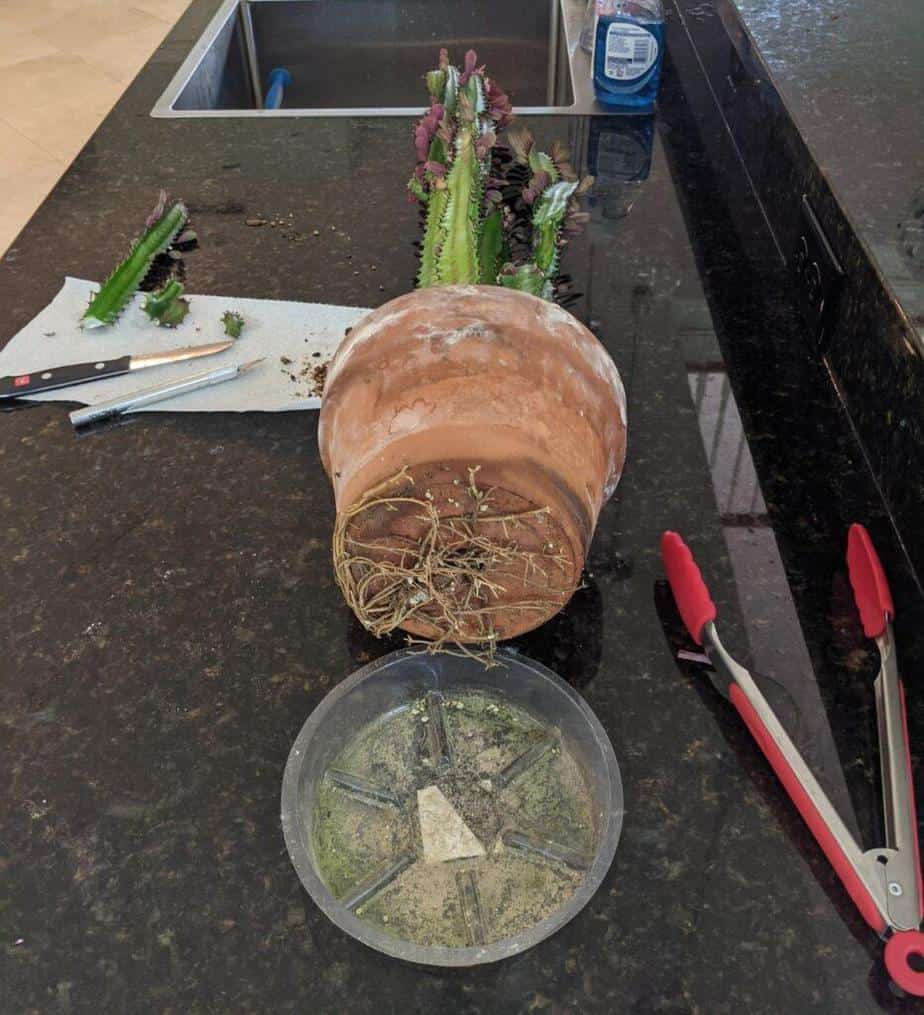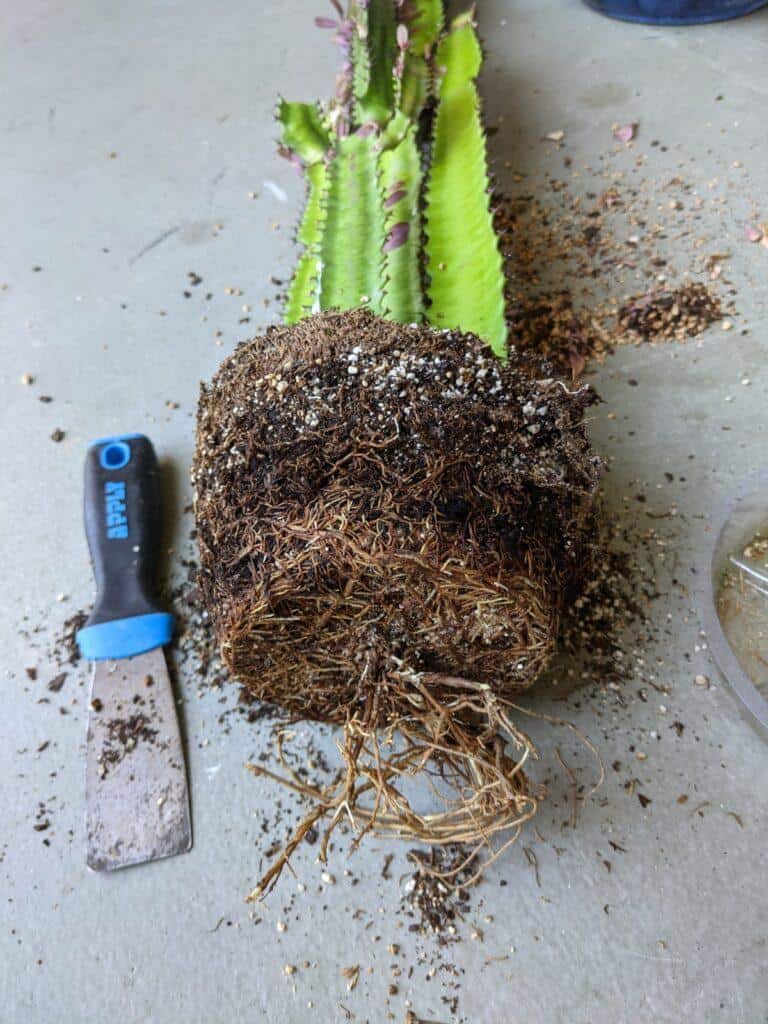Last week I decided to take some cuttings from my Euphorbia trigona to propagate. I have some space to fill up in my greenhouse and propagating a plant I already have IS FREE. I will have another blog on propagating a Euphorbia trigona shortly. I hadn’t looked closely at my Euphorbia trigona for a while. It turns out it’s in dire need of a repot. Today I’ll go over some signs that you need to repot your Euphorbia trigona and some tips on how to safely repot a Euphorbia trigona.
About the Euphorbia Trigona
Euphorbia is a large plant genus you may have heard of it before. Many popular succulents are in this genus and they come in a wide variety of shapes and sizes. Some of my favorites from my personal collection are the Euphorbia trigona (African Milk Tree), Euphorbia milli (Crown of Thorns), and the Euphorbia tirucalli (Pencil Cactus). I love them all because they’re pretty unique looking and in my opinion extremely easy to care for.
Euphorbia Trigona Care
Euphorbia trigonas are awesome houseplants because they grow quickly. In a given growing season I usually get 6 to 8 inches of growth on a stalk even inside. They really like bright light and would do best in south or west– facing windows. Light is really the biggest factor for success, otherwise, they thrive on neglect. Water and fertilize your Euphorbia trigona sparingly.
| Light Needs | Watering Needs | Soil Needs | Fertilizing Needs |
| Bright direct light. | Let soil dry completely between waterings. | Well draining potting soil. | Every 2 weeks during the growing season. |
Euphorbia Trigona Safety
It is important to note that Euphorbia trigonas can be dangerous houseplants. For one, they have spines along the ridges. Their sap, a white substance that drips from the stalk when cut, is a skin irritant. Take it from it that it is. I’ve been careless before and gotten a small amount on my hand. It burned (not immediately), turned my skin red, and the top few layers of epidermis dried up and flaked off. So it’s not to be messed with. It goes without saying to keep these away from pets. I have some tips and tricks for baby-proofing plants in my blog here.
Signs You Need to Repot Your Euphorbia Trigona
Slower Growth
This growing season, my Euphorbia trigona didn’t grow quite as much as usual. I should have taken that as a sign, but I actually didn’t connect the dots until later. There’s not a lot of explanation that needs to be given here. If your plant usually puts on 8 inches a growing season and it only grows a few inches the next season. it’s time to check the roots. A plant that has slowed growth because it needs repotting will be pretty root-bound.
Roots Growing Out of the Pot
This is what tipped me off. Remember I said Euphorbia trigonas thrive on neglect. I hadn’t really inspected mine closely for a very long time it seems. So many roots are growing out of the bottom of the pot, it won’t even sit flat. There are no questions, this plant needs a repot. By the looks of the roots, it needed to be repotted some time ago.

Repotting a Euphorbia Trigona
Prep and Supplies
You need the normal stuff. A new pot. I recommend terracotta because it’s porous and dries out quickly. I tried to find one in a suitable size but my store only had gigantic patio size terracotta in stock. You really don’t want your pot and soil to hold too much moisture so I recommend sticking to a pot that is only one to two inches larger than your current pot.
Choose a well-draining potting soil. I just use an indoor miracle grow potting soil and add a lot of perlite. Perlite improves drainage of the soil mix. I typically like to use about a 3:2 ratio of potting soil to perlite for succulents.
On to safety. You can try to be careful, but you will definitely get poked and you’ll most likely get toxic sap on you if you don’t. Wear long sleeves, this won’t save you from pokes, but it will save you from sap. I use coated gloves that allow me to handle stalks without being ripped apart by the spines. I’ve seen and heard of people using tongs for the same purpose. I just tried it, and I don’t recommend it.

Remove the Euphorbia Trigona From its Pot
In order to repot, you first need to depot. This one was a little tricky. I wish I actually got a picture of this. To get my Euphorbia out of its old pot I had to put down a towel and lay it on its side. I had to use a spackle knife to loosen all the roots from the edges of the pot, like you do a brownie from the pan. I also had to wrangle all the roots growing out of the drainage hole and carefully force them back through that hole. It’s all delicate work. Even when you’re careful you will still be exposed to sap. If you break off even one of the little leaves, sap will come out.

While you have your Euphorbia trigona out of the pot, it’s a good time to inspect the root system. You can loosen them up a little as well. Look for roots that are dark brown or black and are squishy. These are signs of root rot and another reason you would want to repot. If you find rotten roots, carefully remove them with a sharp sterile tool. I would also let the root ball dry out for up to a day outside of a pot.
Pot Up Your Euphorbia Trigona
Once you get it out of the pot it’s time to prep your new pot. Make your soil mix and fill the bottom of the new pot. You want the soil high enough so the plant sits at the height you want in the pot. Then you backfill the sides. With a tall Euphorbia trigona it can be tough to get the balance right. Check from all angles that your plant isn’t leaning too far one way or the other. I don’t have any genius tip for this, I just add more soil mix to one side or the other until I think it looks level.

Clean up
This is a new section that I have never put in a repotting blog before. The Euphorbia tirgona sap is not a joke though. Change your clothes, at least your shirt. Wash your gloves before you use them again for anything. From experience, the sap is not pleasant to encounter on your skin. So learn from my mistakes and take these precautions.
Do you have a Euphorbia trigona saps story? Or a question? Share in the Comments section.

I'm a long time plant lover on the quest to happily coexist with as many plants as I can. Let's grow!
